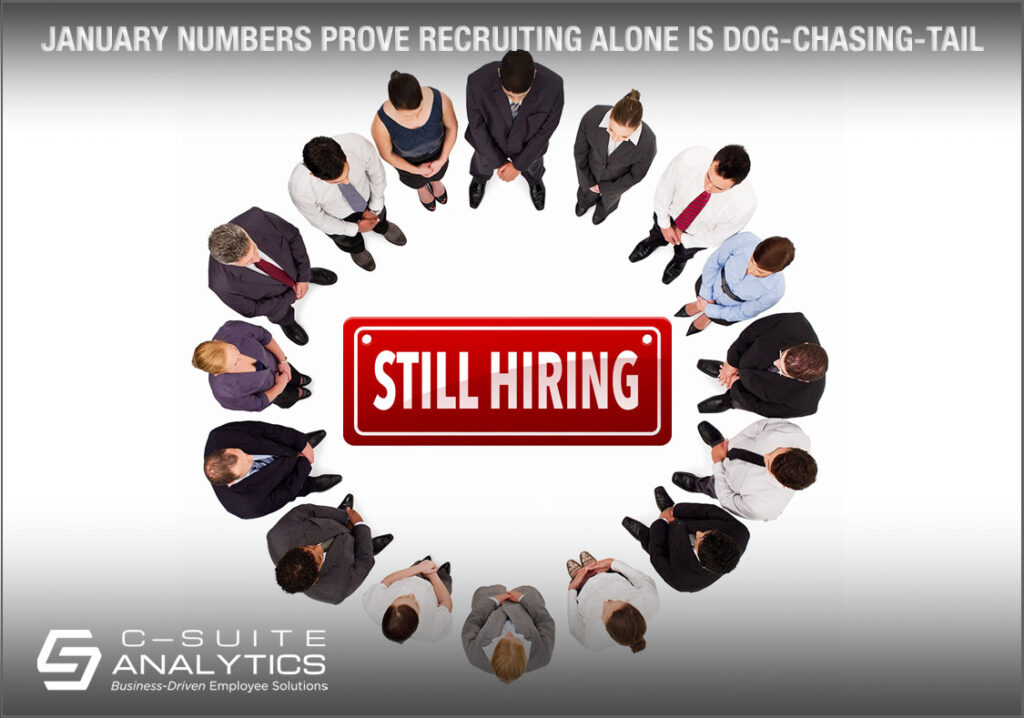What is The Great Resignation?
The Great Resignation was born in April of 2021. Nearly 6 million workers quit that month, leaping beyond the previous month by a whopping 324,000 job-quitters. Then similar numbers of quitters continued each month throughout 2021 until today. As managers and HR leaders struggle to update their employee retention strategy, they do so in the lingering shadow of The Great Resignation as they strive to arm their organizations with the best employees who are “in it” for the long haul.
The chart below details the pattern of voluntary quits beginning in 2009 when the U.S. was recovering from what was then called “The Great Recession”. This data reflects only voluntary quits and excludes terminations based on performance, layoffs, or for any other reason. Readers who are charged with improving employee retention will benefit from knowing not just the historical high points of when employees quit but also the primary reasons why…and those details follow.
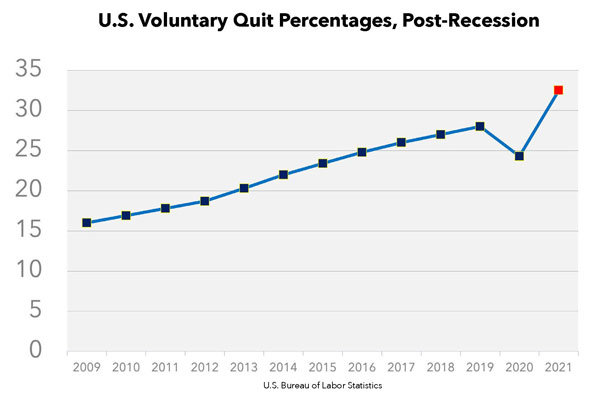
“One-third of U.S. workers voluntarily quit their jobs in 2021. No one saw that coming. Corporate America thought everyone would be glad to have their old jobs back.”
-Dick Finnegan
Why is The Great Resignation Important for Business Leaders to Understand?
The U.S. economy grew steadily from 2009 until 2019, resulting in more jobs and therefore more opportunities for workers to move from one job to another. A full 28% of U.S. workers quit their jobs in 2019 which at that time was the all-time high, presenting what was then the greatest-ever challenge to employee retention. The dip in quits in 2020 was due to the pandemic-driven recession. As this data reports only voluntary quits, the high number of layoffs, furloughs, and other company-driven employment choices during the pandemic is not included here.
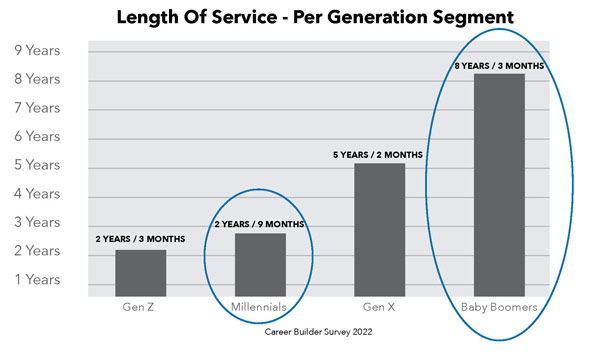 The quit pattern in 2020 was inconsistent. The high-trending pattern of quits seen in 2019 continued into the first two months of 2020, and February in fact posted the lowest unemployment rate during this century at 3.5%.
The quit pattern in 2020 was inconsistent. The high-trending pattern of quits seen in 2019 continued into the first two months of 2020, and February in fact posted the lowest unemployment rate during this century at 3.5%.
The Bureau of Labor Statistics tells us that in December less than 1% of U.S. workers were either “discharged”…their term for fired…or laid off. The precise percentage was .08%, the lowest ever recorded.
Gen Z and millennials comprise more than half of our workforce. And since their dominance in our workforce increases each year, millennials alone will make up a full 75% of our workforce by 2025. So, any prediction that their low current length of service in the current period will continue to grow should send shivers through all of us. The oldest millennials turn 40 this year…meaning those generalizations that all young people are millennials or the reverse, that all millennials are young, have run their course.
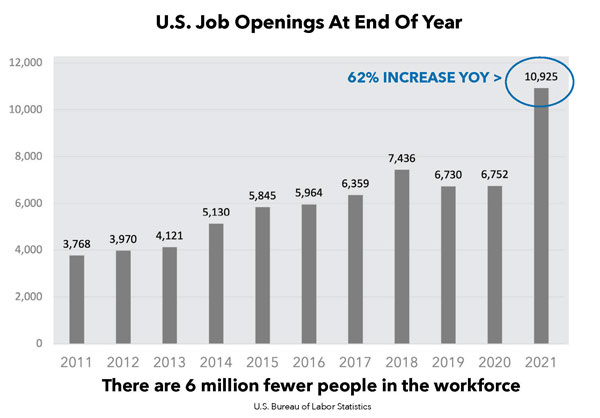
As just one example, August’s 2021’s Bureau of Labor Statistics’ report told us 4.3 million workers quit their jobs, the largest group being about 900,000 from restaurants, bars, and hotels. In a survey, nearly 80% of such workers indicated being hesitant to return to the restaurant industry, citing it as being “a dangerous environment, followed by low wages, difficult or unruly customers, unpredictable and/or inconsistent schedules and a lack of benefits.”
The Great Resignation is Impacting Employee Retention and Engagement
The math tells us just one reason why economists are pessimistic regarding employee retention with 11 million open jobs and 6 million fewer workers. But knowing The Great Resignation is the product of three factors…company behaviors, a major attitude shift, and demographics…then corporate America’s pathway to overcoming it becomes clear.
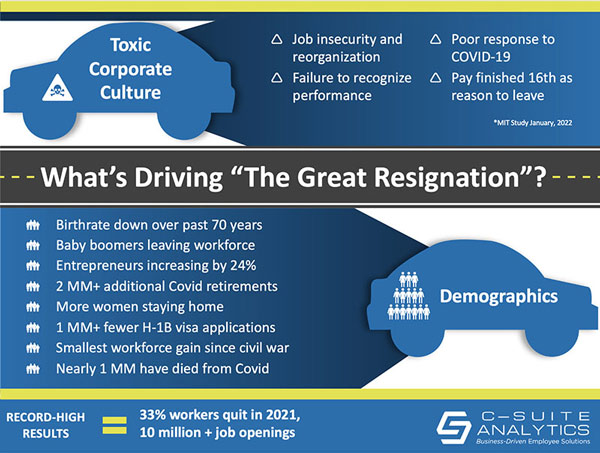 Company Behaviors: MIT researchers conducted a study of why employees quit their jobs beginning in April 2021, the birth month of The Great Resignation. Their top reason was “toxic corporate culture”, citing job insecurity and reorganization, failure to recognize performance, and poor response to COVID-19.
Company Behaviors: MIT researchers conducted a study of why employees quit their jobs beginning in April 2021, the birth month of The Great Resignation. Their top reason was “toxic corporate culture”, citing job insecurity and reorganization, failure to recognize performance, and poor response to COVID-19.
One surprise from the data was that pay finished 16th as a reason why employees are quitting their jobs during The Great Resignation. For perspective, consider the obvious: there are 15 more dominant reasons.
Major Attitude Shift: There is reason to believe the impact of today’s social unrest and employees’ reactions to how their employers treated them during the pandemic plays a significant role in The Great Resignation, and that these events impacted young workers more. The outcome is people taking more control of their lives and destinies, of trusting societies’ institutions less, and therefore distancing themselves from relying on some of the pillars of before including corporate America.
Demographics: One might debate any of the reasons listed above but the demographic shift is as real as an oncoming locomotive. We are living in a decade where the growth of our workforce is lower than any time in our nation except for the years following the civil war. Feeding this shortcoming is the mass of baby-boomers who are retiring against a U.S. birthrate that has been on the decline for 70 years. The year of 2021, in fact, represented the lowest birth rate year in U.S. history.
There are additional, human-made phenomena that have reduced our workforce further including:
• The usual number of retirees doubled during the pandemic.
• Parents who initially stayed home to be with their children who have remained out of the workforce.
• Foreigners who could have legally entered our country to provide medical, scientific, and other professional contributions
have declined, citing America’s “political culture”.
• One million Americans have tragically died from COVID-19, many of whom would be in our workforce today.
• The number of entrepreneurs has increased by 24%, an historical high for a one-year period.
• Many are keeping their newfound self-employed jobs rather than returning to their former corporate ones.
• Some professional workers used their down time by taking online courses to improve their skills.
• Opportunities like driving Uber or even dog-sitting became a better alternative to stodgy corporate work.
• Young workers found ways to easily replace their previous corporate incomes.
The U.S. economy recovered faster and stronger than economists had predicted, far stronger than the rest of the industrialized world. The result is we had nearly 11 million open jobs at the end of 2021, all while trying to fill them with 6 million fewer workers. Given that so many workers were abandoning corporate America while the remaining workers had a plethora of new jobs to consider, employee quits skyrocketed…and The Great Resignation raced forward.
“Many expect the labor shortage to last at least several more years, and some say it’s permanent. Of 52 economists surveyed by The Wall Street Journal, 22 predicted that participation would never return to its pre-pandemic level.”– The Wall Street Journal
“Economists predict that the Great Resignation is only getting started, especially for Gen Z and millennial workers who are well positioned to find new ways to earn income.” – Time Magazine
What Employee Retention Strategies Should I Consider During The Great Resignation?
Remember way back in 2019 when recruiting and retaining our workers seemed so hard? The challenge of recruiting and retaining in 2019 was cake compared to what’s ahead in 2022, 2023, 2024, and 2025. Here are your top items to discuss in your next company strategy session:
- Yes, pay matters but you cannot pay your way out of this, nor can we afford to sustain it; pay matters exponentially more when recruiting versus retaining.
- Employee referrals stay longer, perform better, and are easier to recruit so you must gain 50% of your hires that way going forward.
- The best retention strategy is to hold managers accountable for building trust, retaining employees, and developing them to their potential.
- Keep hiring standards high, even when managers just want a body.
- Ensure new hires get the skill training they deserve to succeed.
- Hold managers who retain poor performers accountable and call them out so they improve or remove them.
Multiple studies disclose that top performers out-perform average performers by 4 to 1. Just one of many academic studies across several industries found that the top 5% of the workforce produced 26% of the participating companies’ total output. Remember that the risk of letting poor performers slide is losing your top performers…and being left with a workforce comprised of low performers and others who just don’t care.
The bottom line is stop waiting for this to pass because it won’t.
What Tactics for Employee Retention Are Working Even During The Great Resignation?
Employee retention solutions must focus on improving corporate cultures that extend way beyond increasing pay. Gallup taught us years ago that improving cultures is more bottoms-up than tops-down, that each supervisor brings her own cultural elements to their jobs each day.
Ensure all c-suite executives and members of your board know that workforce issues are the top-driving, number one strategic mandates for years to come, surpassing all others because your company cannot make any money without people…and the right people.
Retaining top talent is even more important than recruiting top talent. Here is the employee retention strategy that works:
- Dollars: Ensure all leaders understand the cost of employee turnover, annually and by each exit.
- Goals: Recommend specific improvement goals by leader for all turnover and new-hire turnover based on your analysis of recent turnover data, and also recommend precisely who should own responsibility for goal achievement, likely including department managers, HR recruiters, and on-the-job trainers if any.
- Stay Interviews: Train leaders on all levels to conduct Stay Interviews by asking 5 highly researched questions, probing, listening, taking notes, and building individual, one-on-one stay plans.
- Forecast: Train leaders on all levels to forecast how long each employee will stay.
- Accountability: Coach executives to leverage resulting data from goal achievement and forecast accuracy to hold leaders accountable for retention.
Remember way, way back in 2019 when hiring and retaining our teams seemed so hard? No economist can tell us when doing so will be that easy again. Companies fighting to grow their businesses during these times of worker shortages, high inflation, and supply chain issues must retain their best workers through an ironclad employee retention strategy as their best offense to overcome The Great Resignation.

